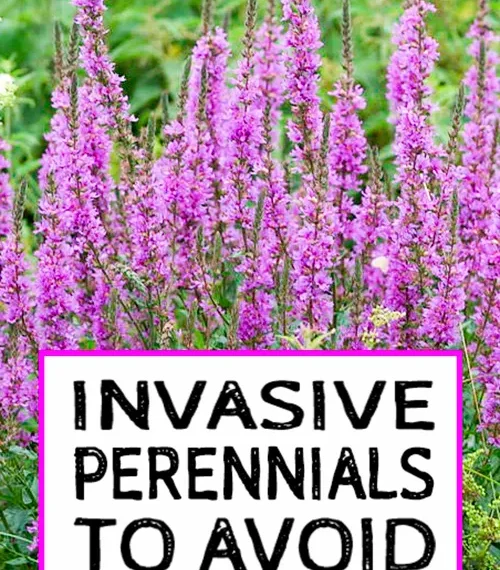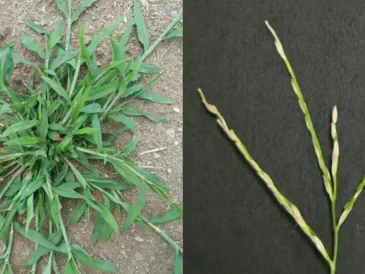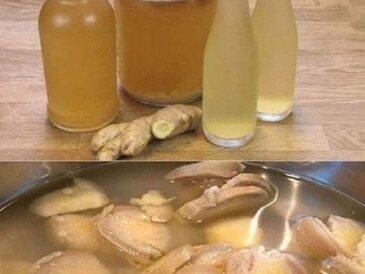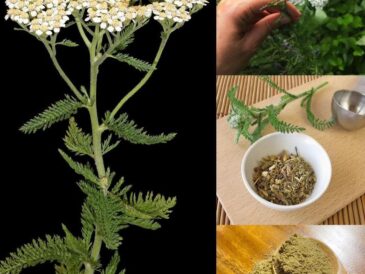This stuff is now considered an invasive species in 19 states.
This is one plant that’s a solid “don’t,” there is no mitigating it.
If you want the beauty of a wisteria-covered pergola, opt, instead, for the native Wisteria frutescens.
5. Trumpet Vine

You can usually tell right away if a plant has a tendency to take over by some of its more common nicknames. For instance, trumpet vine (Campsis radicans) is also known as Hell Vine as well as Devil’s Shoelace. (I thought he was cloven? Can the devil even wear shoes?)

This is another vine that spreads easily both above ground through seeds and below ground through rhizomatic runners. While it is beautiful, it’s also hard to contain. If you do decide to plant it, be ready to spend some time maintaining its boundaries each year.
6. Fish Mint

Fish mint goes by many names: heart leaf, chameleon plant, lizard tail, or fish wort. Despite the plant being edible, the very name fish mint kinda makes me not want to plant it. Apparently, it’s one of those plants you either love or despise the taste of. Despite its common moniker, fish mint isn’t actually a member of the mint family.

It’s native to Southeast Asia, where it’s used both as a culinary and medicinal plant.
However, like the other plants on this list, it tends to get out of hand quickly. This is another plant that’s best grown in a container or not at all.
7. Ditch Lily or Tiger Daylilies

Daylilies are beautiful perennials that add a pop of color and waterfall-like foliage to your landscape. If you’re into eating wild plants, daylilies are a great addition to your garden, as all parts of the plant are edible (and quite tasty). (Not to be confused with Star lilies or Asiatic lilies, which are poisonous.)
However, the orange variety, known as ditch lilies, is invasive. Some areas prohibit their planting.
These are best left unplanted altogether as they spread rapidly, outcompeting native plants.
8. English Ivy

English ivy is beautiful, with its deep green glossy leaves and silvery lines tracing the veins. However, it’s also incredibly aggressive, easily and quickly growing beyond where you want it to and covering everything in its path.
I had to laugh. I was reading information on dealing with Creeping Charlie on one of the land grant school’s extension websites. They suggested planting English ivy instead of Creeping Charlie. Ah, yes, let’s swap out one aggressive invasive species for another.
If you want to enjoy this truly beautiful plant, it’s best to grow it in a pot as a houseplant. (Of course, that’s the surest way to kill any tough, invasive plant – bring it into a house and try to keep it alive.)
9. Bamboo

If you don’t like your neighbor and want to make their life miserable, plant bamboo in your yard. (I’m kidding. Please, don’t.)
Just don’t plant bamboo at all. Trust me.
I shake my head every time I pass a stand of bamboo in someone’s yard. Once you plant it, that’s it, you’re done. It will keep spreading, year after year, smothering native plants.

Bamboo is an allelopathic plant. It produces its own natural herbicides that kill off other plants around it, giving it headway to take over.
If you must plant bamboo, choose a clumping variety rather than a running variety, as it’s slower to spread. However, this is one plant where there really is no mitigating it and eradicating it is time-consuming and expensive. It’s best to skip it altogether and opt for something else.
In the end…
You’ve likely noticed that my suggestion for most of these plants is to grow them in a container. However, plants have a knack for spreading regardless of our careful plans. After all, it’s what they’re genetically designed to do – ensure they keep growing generation after generation.
The easiest option is not to plant them at all.
If you like the look of them, or have a specific design element in mind, you can contact your local extension office or visit a local nursery for native plants or alternatives.




